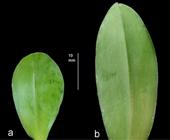Abstract
Phalaenopsis amabilis Blume var. grandiflora Bateman is economically important as cut and pot flower. Polyploidy is considered as a valuable tool in improvement and evolution of ornamental plants. Protocorm-like bodies (PLBs) of P. amabilis were cultured on Murashige and Skoog medium containing 0.20 mg L-1 IBA together with 2.00 mg L-1 KIN and 1.00 g L-1 activated charcoal and grown for a period of five months. Fully-developed plantlets from in vitro grown PLBs were immersed in a bubble reactor filled with half-strength Hoagland solution containing the antimitotic agent colchicine (0.05%, 0.10% and 0.15%, w/v) for 72 h with a few drops (1 mL of 0.1%) of octylphenoxypolyethoxyethanol or Nonidet (P-40) as a surfactant. Plantlets were aerated to prevent hypoxia. Colchicine-treated and untreated plantlets were transferred to pots for a period of 60 days. Tetraploidy was successfully induced by 0.15% colchicine. Polyploidy levels were firstly detected using flow cytometry and then confirmed by cytological and morphological observations. The chromosome number was 2n = 2x = 38 in diploids and 2n = 4x = 76 in tetraploid. Incubation of plantlets in liquid medium containing 0.15% colchicine induced the maximum recovered tetraploids with minimum frequency of survival (50%). The tetraploid plants were more compact and exhibited round and thick leaves with darker green color than diploids. Stomata size in tetraploids were larger with less density than diploids. Chloroplast number in guard cells of tetraploids was about two times more than that of control. These results indicate that induction of tetraploids are a reliable and powerful tool for generation of novel phenotypes with ornamental and horticultural value for genetic improvement and breeding. Produced tetraploids in current study have potential in the ornamental/floriculture trade.
Keywords:
antimitotic agents; chromosome set doubling; orchids; ornamentals breeding; tetraploid

 Thumbnail
Thumbnail
 Thumbnail
Thumbnail
 Thumbnail
Thumbnail


